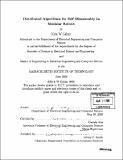Distributed algorithms for self-disassembly in modular robots
Author(s)
Gilpin, Kyle W
DownloadFull printable version (42.89Mb)
Other Contributors
Massachusetts Institute of Technology. Dept. of Electrical Engineering and Computer Science.
Advisor
Daniela Rus.
Terms of use
Metadata
Show full item recordAbstract
We developed a modular robotic system that behaves as programmable matter. Specifically, we designed, implemented, and tested a collection of robots that, starting from an amorphous arrangement, can be assembled into arbitrary shapes and then commanded to self-disassemble in an organized manner. The 28 modules in the system were implemented as 1.77-inch autonomous cubes that were able to connect to and communicate with their immediate neighbors. Two cooperating microprocessors controlled the modules' magnetic connection mechanisms and infrared communication interfaces. We developed algorithms for the distributed communication and control of the system which allowed the modules to perform localization and distribute shape information in an efficient manner. When assembled into a structure, the modules formed a system which could be virtually sculpted using a computer interface which we also designed. By employing the sculpting process, we were able to accurately control the final shape assumed by the structure. Unnecessary modules disconnected from the structure and fell away. The results of close to 200 experiments showed the that the algorithms operated as expected and were able to successfully control the distributed system. We were able to quickly form one, two, and three dimensional structures.
Description
Thesis (M. Eng. and S.B.)--Massachusetts Institute of Technology, Dept. of Electrical Engineering and Computer Science, 2006. Includes bibliographical references (p. 225-226).
Date issued
2006Department
Massachusetts Institute of Technology. Department of Electrical Engineering and Computer SciencePublisher
Massachusetts Institute of Technology
Keywords
Electrical Engineering and Computer Science.